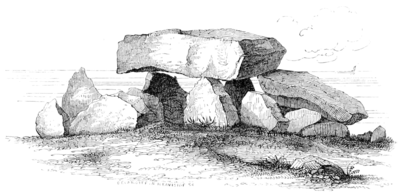ON THE PRIMEVAL ANTIQUITIES OF THE CHANNEL ISLANDS.
The cromlechs of the Channel Islands, from whose enclosures, intermixed with the vestiges of mortality, have been obtained a variety of stone instruments, well adapted to the necessities of a rude and simple people inhabiting the wilds of a primitive country, vary in their arrangement and construction precisely in the same manner as has been observed in other countries.
It has been remarked that several of them are placed nearly east and west; this is often the case in these islands as well as in France, but whether from accident or design, it is difficult to decide: many in Brittany are due north and south; two out of three at L'ancresse in this island, are also in that position; and in the plain in the island of Herm, one due east and west is only 30 feet distant from another north-west and south-east; with this exception, all the large cromlechs, in Guernsey at least, are placed east and west.
The general shape and position of the stones differ in no respect from those of other countries, except in size and material. Large and ponderous granite blocks, supported on massive props, (usually placed with the smaller ends downward,) constitute this lonely chamber of the dead. Occupying the interstices of the props are found smaller stone works, so wedged and adapted as to prevent the falling in of the ground, or tumulus, which accompanies the sepulchre. A large circle of single upright stones planted at uniform distances from each other, and from the first stones laid down, completes the structure under consideration. A slab, or a flat

